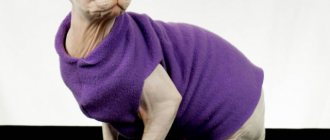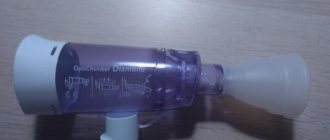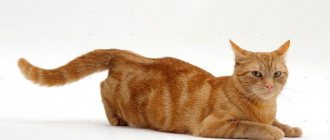Water procedures should be carried out regularly. Moreover, regardless of whether the pet has the opportunity to go outside or not. True, sometimes you have to perform such actions unscheduled, and the hygiene product runs out at the most inopportune moment.
It’s worth figuring out how to wash your cat if there is no special shampoo, and what you can replace it with.
When should a cat be washed?
The need for water procedures may arise in different cases.
Lots of fleas
If an animal is infected with parasites, treatment should be carried out without delay.
True, you won’t be able to rid your kitten of fleas using regular shampoo. You need to use special products designed for pest control at home.
Contaminated with toxic substances
If toxic substances come into contact with a cat's fur, bathing is mandatory.
It cannot be postponed, otherwise irreparable harm may be caused to the pet’s health.
Other reasons
There are a number of other cases when you need to bathe your pet:
preparation for the exhibition;- severe contamination of the coat;
- period of intense molting;
- strong unpleasant odor from the cat.
How often should I bathe?
According to the standards established by the World Society of Animal Health:
- Domestic cats need to be bathed three to four times a year.
- If your pet is used to walking outside, then the frequency of bathing should be increased to 6-7 times a year. It is also necessary to clean the furry paws when he comes home from the street.
If your furry pet is dirty and a source of unpleasant odor in the apartment, it’s time to seriously think about solving this problem. Read from a special article on our website how to remove the smell of cat urine.
You shouldn’t get carried away and wash your cat often, especially if there are no detergents designed for this purpose, and you are looking for options on how to wash your cat if there is no special shampoo. Frequently repeated water procedures, and especially with alternative means, leads to a disruption of the pH level (skin fat balance) of the animal, and then the natural protection on the cat’s skin disappears.
Important! Despite the frequency at which it is recommended to bathe cats, it is still better to do it as rarely as possible. It would be a better decision to focus on a balanced diet for the mustachioed. By eating right, he will not be afraid of any infections or pollution.
Soap or shampoo for people: are they suitable for cats?
You can use soap. In emergency situations, the use of this product is acceptable, but it is necessary to choose brands that do not emit a strong aroma. It is recommended to give preference to baby soap.
Regular shampoo is not the best solution. It is allowed to be used only once. At the same time, you need to try not to soap the animal too much. It is best to make a weak soap solution and treat your pet with it, then rinse immediately.
What happens if the animal is regularly washed with a non-special product?
The systematic use of shampoos that are unsuitable for cats leads to changes in the structure of the hairs, the activity of the fatty glands is disrupted, and the condition of the skin deteriorates .
The development of allergies cannot be ruled out.
Because of this, the immune system weakens. The pet becomes more susceptible to various diseases.
When is it better not to bathe?
Having picked up a kitten on the street, you should give it a bath, this will be safer for both you and it. If the baby was purchased from a breeder and lived in good conditions, it is better to postpone the first full bath until the age of 5–6 months. The danger of bathing a baby is not a possible cold (although this is also a good reason), but injury. Kittens are much stronger than they appear, they are harder to hold, and falling from a height or landing awkwardly can result in serious injury.
You should not bathe until you have received full vaccination . The fact is that the first vaccinations are carried out in two stages, between which the immune system actively “works” to defend itself against weakened viruses. Possible hypothermia and stress associated with bathing can adversely affect the general condition of the pet. As your pet grows, you need to introduce him to water, perhaps even to a bathroom or a filled basin. By the way, not all cats are afraid of water; some of the four-legged cats like to lie under a stream of water in the sink.
Pregnant cats should not be washed until birth . When kittens are born, you need to look at the situation; some four-legged animals need to be washed, especially long-haired ones. An alternative is a pre-made hygienic haircut: shortening the hair on the stomach and groin area. If possible, a cat who has given birth is not bathed until she has nursed her kittens. The body of each animal is individual and there is no guarantee that a young mother will continue to lactate successfully after a temperature change during bathing and drying.
Important! If you had to bathe a pregnant or lactating cat, try not to use shampoos and other chemicals, thoroughly rinse and dry the fur after bathing, make sure that there is no foam or detergent residue on the pet.
It is worth understanding that the longer the pregnancy, the more careful you need to handle your pet. In the second half of pregnancy, even slight hypothermia can cause premature birth, and premature kittens are known to survive very rarely. Not all, but many cats are afraid of water. If the expectant mother cat is under severe stress, miscarriage can occur early.
Naturally, you should refrain from bathing if the cat is seriously ill, has recently recovered, or has undergone surgery . If there is a critical need, the pet can be partially washed, but it is better to get by with a “dry” bath. To remove dirt, you can use baby powder mixed with starch. The resulting powder is rubbed over the wool, and then combed out with a fine comb.
Note! In most cases, after flea drops, it is not recommended to bathe your cat for 4-7 days.
Shampoo substitutes for cats
If washing needs to be done immediately, and there is no special shampoo, you can use those products that are intended for children. They do not contain fragrances, surfactants or chemicals that can cause harm.
Products that meet the following requirements are considered suitable for pets:
simple composition;- absence of allergenic components;
- The smell is weak, neutral.
Preference should be given to shampoos intended for children under three years of age.
Such products act gently and as carefully as possible. With their help, it is possible to clean the fur and skin without causing harm to the animal.
How many times should cats be bathed and is it possible to do it every month?
When and how often to take a bath depends on several factors:
- Is your cat always inside the house or does it go outside? Street pets need care more often.
- Is the fur long or short? Long-haired representatives require more thorough and frequent coat care.
- Is the animal active or calm? Active cats get dirty faster.
Professional groomers do not recommend bathing frequently. Once every 4 – 6 weeks depending on the situation will be sufficient. And scientists have proven that after washing, animal fur contains 80% less allergens*, and in this case, you need to bathe your furry pets at least once a week.
Regular bathing can help relieve allergy symptoms
Unless there are medical indications or allergies, do not wash your cat more than once a month. Water washes away the protective oils from the fur, which reduces the coat's natural defenses against dirt and makes it dull.
Types of cat cleaning products
All products intended for cats can be divided into three groups:
- liquid;
- dry;
- sprays.
Each type has both advantages and disadvantages. Therefore, it is worth considering them in more detail.
Liquid shampoos
Considered the standard view.
High-quality products not only clean the coat, but also make it silky and soft. There are both general and specialized ones: against tangles, against fleas, etc. Shampoos should be used up to three times a year. Their more frequent use can lead to disruption of the sebaceous glands.
Dry products
Preference is given to such options if the pet is terribly afraid of water.
Dry products cope with the task assigned to them as effectively as liquid ones. In addition, their use makes combing easier.
Cat fur takes a long time to dry. The slightest draft can lead to a cold. In addition, you need to make sure that water does not get into your ears.
If dry powder is used, these problems do not arise. Even with frequent use, the skin does not dry out.
Sprays
Another convenient type of pet supplies. True, finding them on sale is very problematic.
In addition to cleansing wool, this product creates antistatic protection. But the aroma of the spray is often more pronounced than that of other types. This is perhaps one of its few shortcomings.
The product is applied using a sprayer. When applied, it makes noise and may frighten your pet.
What products should you use to wash your pet?
When the question arises of how to wash a cat if there is no special shampoo, many owners do not go into detail and bathe it with what they have in the house. And some people never buy special products at all - so they spend their entire lives washing their pets with their own, “human” products.
Important! As mentioned above, cats have their own pH level (acid-base balance), and it is very different from humans. With the constant use of regular shampoos or soaps, the pH level of cats is disturbed. This leads to overdrying of the skin, dandruff and loss of shine in the fur. This point is taken into account when developing and producing those shampoos that are intended for washing cats.
So, when you choose what to wash your cat with, you have the opportunity to test and then decide which product is right for your pet from the following three:
- regular shampoo;
- dry shampoo in powder form;
- spray shampoo.
Important! If you just took such a fluffy into your apartment, a detailed review on the topic of which litter box is best to choose for a cat will definitely help you.
Their differences are as follows:
- The shampoo is in the usual format and is also used as usual. You need to choose, taking into account the pet’s parameters - the type and color of the skin. And also, if you have parasites or just need prevention from them, you can choose a product with substances that kill fleas on the fur of a mustache. There are also those that are designed to improve combing, against dandruff, for shine and others.
- Powder shampoo is used when your animal is very afraid of water. They apply it to the pet’s dry fur, and then comb it thoroughly. Together with the shampoo, dirt, dust, unpleasant odors, etc. are removed.
- Spray shampoo is the same as shampoo, only with a convenient spray bottle, which eliminates the need to pour it into your hand.
When there is no special shampoo - what to do?
How to wash a cat if there is no special shampoo? In a good way, when there is no money, it is better to bathe the animal when you buy it. At best, if the fur is completely dirty, wipe the body with a soft, damp cloth.
If you still need to wash, take shampoo for children under 3 years of age or children's liquid cream soap. Do not wash with shampoos and gels for adults, otherwise the skin’s fat balance will be disrupted, because “human” products have a bad effect on the health of the skin and hair. What can we say - various fragrances, dyes and additives do not at all contribute to the good condition of cats, and the smell will cause an anxious mood.
Important! If you did bathe the mustachioed one with a “human” remedy, try not to repeat it again. Stock up on cat shampoo.
Groups of shampoos by direction
All shampoos intended for cats are divided into several groups. They are medicinal, cosmetic, antiparasitic and special.
To make an accurate choice, you should consider each of the categories in more detail.
Medicinal
They are used to solve a specific problem. For example, killing bacteria, eliminating the symptoms of an allergic reaction, treating ringworm or fighting dandruff.
You cannot resort to self-prescribing such shampoos. You should first consult a veterinarian.
Cosmetic
Such shampoos are used to cleanse the animal and give it a fresh, well-groomed appearance. In fact, this is a classic hygiene product. It does not perform any additional functions .
Special
Designed for hair care. There are bleaching, tint, suitable only for oily or dry wool. Products designed for a specific breed are also available.
Antiparasitic
Designed to destroy parasites, such as lice, fleas and ticks. Such products contain toxic substances that cause the death of insects.
To make the use of antiparasitic shampoos as safe as possible, you must strictly follow the instructions on the packaging.
Why are unscheduled water treatments needed?
There are several cases when there is a need, even a necessity, to bathe your pet, despite the fact that you do not know what you can use to wash the cat if there is no special shampoo. In the end, you use what you have at hand:
- if the cat is purebred and participates in all sorts of competitions and exhibitions, then before each such event, breeders usually wash such pets;
- in the case of some severe contamination that the cat cannot lick on its own, or which has toxic properties and the animal, while licking itself, can be poisoned;
- as we have already mentioned, with heavy shedding, this can harm the digestion of a mustachioed cat, especially for long-haired cats.
Important! Another nuance is caring for the animal in summer and autumn. Here you will find useful information on how to remove fleas from a cat.
The importance of choosing the right detergent for your furry pet
If the shampoo is chosen incorrectly, it will negatively affect the condition of the cat's coat.
The hair will become brittle, dull, begin to get tangled, and form clumps. The skin condition may worsen. When using inappropriate products, the dermis becomes dry and there is a risk of dandruff.
It is important to take a responsible approach to choosing shampoo.
Your pet needs to be given proper care to avoid problems with its fur and skin . Responsibility for the health of the animal lies with the person.
Bathing a cat
There are not many reasons for giving an emergency bath Most hairless cats need to be bathed or wiped down with special wipes, but these breeds are more likely to be the exception to the rule. If your pet proudly wears a fur coat, bathing will be important :
- In case of parasitic infestation - fleas, ticks.
- In case of severe contamination , this is important if the cat is walking on the street or has become dirty with something in the home.
- During or after estrus - if the coat is heavily soiled. In order to avoid bathing long-haired cats, you can contact a groomer and give your pet a hygienic haircut.
- After giving birth , only if the cat is very dirty and does not have the strength to wash itself, in this case you need to use powdered shampoo; in all other cases, bathing is postponed until the kittens are fed.
- Before castration is a requirement of most veterinarians.
A few hours before bathing, the pet should not be fed , as it may vomit from excitement. It is not recommended to bathe your pet under running water or a shower head, as most cats are very afraid of this. Tune in to the fact that bathing is a serious process that should take place as quickly and quietly as possible, literally. Close the bathroom door and don't let anyone in until you're done. If you decide to enlist the help of a family member or friend, they should be with you from the beginning to the end of the process, but only intervene when necessary. Naturally, all these tips are not universal; some cats love water and calmly lie in the basin while they are washed.
So, everything will work out if you set the right mood and prepare. To fully equip your cat for bathing you will need:
- Assistant - if you are not sure that you can handle it yourself or are bathing your pet for the first time.
- Large basin if you are not sure that the cat will be calm when bathing in the bath. The second option is a sink. If you bathe in a sink, you need to plug it with something.
- A large, heavy towel or non-slip mat is placed on the bottom of the basin to prevent the cat's paws from slipping.
- Several sheets or towels (if the floor is tiled, it is better to wet them a little in advance) - cover the floor, since the cat will resist, splashes will fall on the floor and it will become slippery, and this is unsafe for you. The second point is that if the pet breaks free and jumps, it will not slip and be injured during the landing.
- Bath thermometer - if you don't know how to determine the temperature by touch.
- Clothes with long sleeves and trousers, preferably the fabric is thick, but not easily soiled.
- For bathing cats that are prone to bite in self-defense, it is better to use gloves.
- Shampoo for bathing cats.
- Towels for drying hair after bathing. Some cats are not afraid of the sound of a hair dryer, check if your pet is one of the exceptions - prepare a hair dryer.
- Roll a large piece of cotton wool into voluminous, dense balls and plug your pet’s ears if you need to wash your hair.
- Antiseptic and dressing material for you.
Important! All prepared accessories should be at arm's length.
Step-by-step instruction
Preparing the bathtub/sink basin is a top priority. Cover the bottom with a towel or mat, then fill it with water, but not more than 10 cm in height. We lower the thermometer to make sure that the water temperature corresponds to the cat’s body temperature (38–39°). If you don’t have a thermometer, rely on your feelings - pour water on your dry wrist, if it doesn’t seem too cold or hot, the temperature is right. Believe me, the cat has already understood everything if it is not the first time she has been bathed, but still take her in your arms and try to distract her by stroking her.
Say all your intentions out loud, only after making sure that the pet does not panic, gradually lower it into the water. Next, follow the instructions:
- Hold your cat firmly, even if she appears relaxed. Too many cats pretend to accept their fate just so that the owner will loosen his grip.
- Try to ensure that the cat has maximum visibility; the clearer she understands what is happening, the less she will panic.
- Cotton balls can be used not only to wash your hair, but also to muffle the audibility, however, in this case you will definitely need the help of another pair of hands.
- Lather the shampoo diluted with water in a small container and only after that, wet the cat well.
- The diluted shampoo is poured along the spine from the withers to the tail.
- Rub the wool and remove excess foam.
- Use a terry cloth or towel soaked in clean water to wipe your ears and ears.
- We thoroughly rinse the wool, the flowing water should be clean (without foam).
- We run our hand over the wool with little effort to bend the water out of the wool as much as possible.
- We wrap the pet in a towel; if it immediately gets wet through, we change it to a dry one.
After holding the cat in a towel for 5–10 minutes, you can release it to the floor, but only in a room without a draft . Don’t be surprised if your pet wants to hide in a more secluded place; bathing is stressful and has unpredictable consequences. It is for this reason that inexperienced owners are strictly advised not to bathe their cat alone. If you have a large or very strong pet, you have doubts that you will be able to keep your ward and cannot find an assistant, you should contact a grooming salon for help.
Advice: if your cat calmly tolerated bathing in the salon, you should not assume that the procedure will go just as smoothly at home. In unfamiliar surroundings, animals behave much more restrained.
There is no particular difference in the algorithm for bathing an adult cat and a kitten , except that for babies, the water needs to be made a little warmer, and after bathing, keep the pet in a towel longer. There is a significant difference when choosing a shampoo, especially when it comes to a product to get rid of parasites. There is an advantage to bathing a kitten - it is easier to hold, but there is also a disadvantage - if you are not gentle and careful enough, your baby will be afraid of water.
Preparation
Washing a cat with claws is dangerous for the owner. It is better to trim your pet's nails the day before bathing. This procedure is also unpleasant for animals and is best not combined with washing.
The last meal before the bath is approximately 3-4 hours. Otherwise the cat may vomit.
Close the windows in the apartment to prevent drafts. Indicators of indoor air temperature are no less important. It must be at least 22 degrees.
Domestic cats are sensitive to hypothermia and can quickly develop a cold. Remove all small breakable items from the bathroom shelves in case the cat gets rowdy.
Comb the animal thoroughly. Especially check the armpits, groin, stomach, and behind the ears to ensure there are no tangles. A cat cannot be bathed with matted fur - this is a mandatory condition.
There will be no opportunity to move away from the cat while washing. Therefore, bath accessories are prepared in advance.
Required:
- cat shampoo;
- washing brush;
- towels (2-3 pcs.);
- rubberized mat.
You can wash your cat in a sink (more suitable for kittens), a bathtub with a shower, or a basin with high sides in which she can stand on her feet. Fill up with water so that the level is no more than 10 cm. It is better to do this without a pet.
Many cats may be afraid of the sound of pouring water, and they will quickly sense that the owner is up to something. Water temperature is 38-39 degrees.
If there is no shower, prepare a container of water for rinsing. You will need 2 buckets of warm water. Spread a thick mat or towel on the bottom of the bath to keep your pet stable. It is important for cats to feel safe.
[custom_ads_shortcode3]
How to properly wash a cat: procedure
Now comes the hard part. How to quickly and painlessly wash a cat?
- Immerse the animal in water. Hold it with your left hand throughout the procedure.
- Douse your pet with water from a ladle or your hands to moisten the fur. We do not recommend using a shower hose or water tap - these noisy plumbing items can greatly frighten the cat.
- Pour some shampoo into your palms and lather.
- Gently apply the product to your pet, avoiding the area around the eyes and nose. Rub the shampoo into the fur and massage the cat's skin with light circular movements. Thoroughly rub the most contaminated areas: paws, top of the tail, belly, between the ears.
- Rinse off the shampoo with clean warm water. Make sure that there are no slippery areas of soap left on the fur, because the cat will lick itself after bathing.
- Wrap a clean pet in a terry towel and hold it in your arms. Let the natural fabric absorb excess moisture. After 2-3 minutes, release the cat so that he can clean himself up.
We invite you to familiarize yourself with a couple more useful tips on how to wash your cat correctly.
- Do not pour water on your pet's head - use a damp swab or soft washcloth.
- Make sure that water does not get into the cat's eyes, nose and ears (otherwise an inflammatory process may occur).
- Calm the animal with praise and kind words, do not make sudden or noisy movements, and take your time.
- Do not use a hairdryer to dry your pet's fur.
We recommend: How to clean the seams between tiles from dirt and mold using a paraffin candle
How to teach a cat to bathe?
It is advisable to accustom your pet to water at a young age - from 3-4 months. Babies are not bathed because they still have weak immunity (there is a high risk of catching a cold) and too sensitive skin.
During the first two procedures, wash only the kitten's paws. This will build trust in your pet, and next time he will agree to a full bath.
Washing a cat is a complex undertaking that requires the owner to be responsible and careful when handling the pet. Any mistake can lead to fear and reluctance of the animal to take a bath next time. Before washing your cat, carefully read the rules described above again and prepare thoroughly.
How to wash a cat if she is afraid of water
Cats don't like to swim. And if the pet has not been accustomed to the bath procedure since childhood, it will break out for the first time. In the second, the resistance will become even stronger.
And if a cat is afraid of water, it is almost impossible to keep him. The solution is to use dry shampoo or a special spray. The product cleanses well, does not affect the condition of the skin, and is suitable for frequent use.
Mode of application:
- The wool is combed.
- Dry shampoo is distributed with light massaging movements. Shampoo particles bind to grease, dirt, and increase in volume, making them easy to remove with a brush.
- Combed out.
The principle of using the spray is the same. Only a hissing sound can scare a cat.
Breeders do not recommend frequently resorting to dry shampoo, since the product will end up in the pet’s stomach, even if only in small quantities.
[custom_ads_shortcode1]
Drying
After the detergent is rinsed off, you need to squeeze out the fur using stroking movements. Wrap the cat in a towel. Long-haired cats should not be rubbed with a towel - there is a high risk that the hair will become tangled.
Just get wet. If one is not enough, you need to use another towel.
Short-haired cats will dry themselves without any problems. Long-haired dogs should be dried with a hairdryer on the quietest and most neutral setting, combed and applied with a spray with an antistatic effect.
Cats don't like to stay wet for long. Therefore, drying must be fast. However, cats have an ambiguous attitude towards hair dryers.
If you don’t teach it from childhood, the sound and strong breath will cause fear. If you cannot use the device, it is important to comb your pet thoroughly. Until the cat is completely dry, you should not let him outside or into a draft.
If your cat trembles after washing, it means either that he is cold or that he is scared. You need to dry the animal as quickly as possible, while petting it, talking affectionately, and giving it a treat. After half an hour or an hour, the cat will stop trembling and calm down.
[custom_ads_shortcode3]











